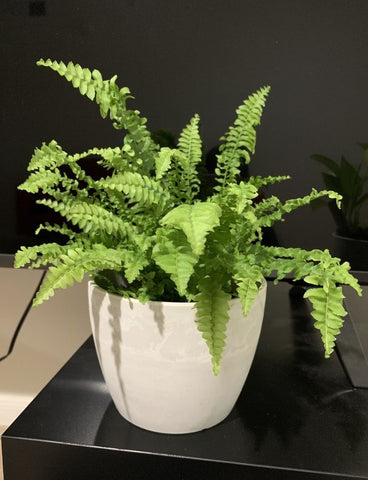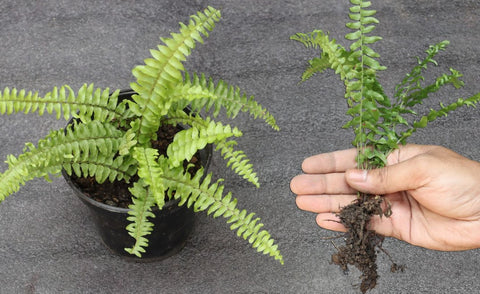Gift Card Balance
Enter the code below to redeem your gift card

Do you find the lush, feathery foliage of a Boston fern attractive? This pet-friendly plant can lend an elegant charm to your home or office. And it can thrive for years with proper care.
Boston fern care may seem a little daunting at first if you’re a beginner. But if you ask a plant parent who has had this beauty for a while, they’ll assure you that it’s easy to nurture once you know what it needs for flourish.
This indoor plant doesn’t need a lot of water, and it thrives in high humidity. However, you must keep your beautiful Boston fern away from direct sunlight.
Keep reading to learn how to care for a Boston fern and find out about its growing requirements and the most common problems with the plant.

The Boston fern, or Nephrolepis exaltata, is easily recognizable, thanks to the plush arching fronds. Its unrestricted, natural growth can give your indoors a woodland touch. This tough and bushy plant is easy to grow and care for. While adding a wild forest charm to your interior space, this gorgeous plant can also help you improve the air quality in your home, due to its proven air-purifying properties.
It’s originally from the forests in southern North America, growing in Mexico, Florida, and the West Indies. In the wild, this green beauty can grow as tall as 7’! When grown as an indoor plant, it usually attains a height of 8”-14”. There’s also the smaller variety, the Lemon Button fern, which is about half the size of a Boston fern.
One of the reasons Boston ferns are popular houseplants is that they’re easy-to-grow plants. It needs indirect sunlight and just enough water to keep the soil moist.
The plant easily flourishes in the average temperature range inside a house. However, Boston fern care indoors requires some attention to the humidity levels of your home.

Boston ferns are low-maintenance plants that thrive outdoors and indoors. If you want to keep it indoors, a bathroom with a window that receives indirect sunlight is a great spot to place it. This popular type of fern looks best in a hanging planter with its fronds cascading gracefully.
To ensure that you follow a proper Boston fern indoor care routine, water your plant once every 7-10 days, based on the soil condition. Wet the soil till water drains through the holes, and let it dry before giving it its next drink.
The same rule applies if the plant is outdoors, too. Dip your finger into the soil to check if the top few inches are moist or not and water accordingly.
You can water Boston ferns from above but do so close to the soil to prevent wetting the fronds. Otherwise, the splashes on the leaves may promote fungal issues.
Bottom watering is also ideal for providing moisture without making the soil soggy. Place the pot in a water-filled tub till the soil surface gets dampened evenly. Then remove the plant and ensure there’s no water sitting in the tray.
If a Boston fern is overwatered, its leaves will become discolored and soft. The fronds can also turn mushy and start to droop. In addition, the soil develops a distinct odor of decay as the roots begin to rot.
If you don’t take immediate action, the symptoms will aggravate. People often mistakenly water Boston ferns on a fixed schedule even if the soil is moist. This, unfortunately will lead to the above problems, which indicate clearly that the plant is being overwatered on a regular basis.

Boston ferns thrive in bright but indirect sunlight. A spot near a window with filtered or dappled sunlight is perfect for this tropical houseplant. The same applies if you’re caring for a Boston fern outdoors. Keep the plant out of direct sunlight. It will be fine in partial shade on your patio or under some trees in your garden.
While Boston ferns should be kept away from direct sunlight, they can’t handle prolonged low-light conditions. This fern needs at least a few hours of bright, indirect light each day. The soft sun rays in the morning are a great source of light for this plant.
Underexposure to sunlight will simply harm the well-being of your fern. The result will be a stunted growth, and yellowing or dull-looking fronds.
While Boston ferns won’t grow properly in full shade, they can’t handle full sun, either. Excessive sun exposure, especially during the afternoon hours in the summer, can scorch their fronds and damage the plant.
The only time, the plant will feel OK in direct sunlight, is during the early mornings when the light is weak. Otherwise, it should get indirect light only.
Boston ferns thrive in a temperature range of 68°F-78°F. The nighttime temperature should be above 55°F. While it can survive in 40°F-50°F, prolonged exposure to such low temperatures isn’t recommended.
This plant also needs a humid environment and flourishes properly when it gets 80% relative humidity. However, it can survive and grow in a level of 60%-70% humidity.
Since the Boston fern prefers humid growing conditions, you should mist it frequently during dry periods in the summer. For a consistent air-moisture level, you can use humidifiers or pebble trays.
However, don’t make the environment too swampy. Ensure proper air circulation to prevent fungal infections and disease issues.
Boston ferns grow nicely in evenly moistened, well-draining soil. Fertilize the plant twice a year during the growing season and repot it once every two years.
Boston ferns love nutrient-rich, well-draining soil with a pH level of 5-5.5. Pick an organic loamy soil mix, preferably peat-based, and add perlite to improve the drainage. Amend it with 25% compost.
Fertilize the Boston fern twice a year during the growth seasons, in the spring and summer. Dilute a balanced liquid fertilizer for indoor plants and feed the plant after you've watered it.
Avoid wetting the delicate fronds of the plant when applying the liquid food solution to prevent chemical burn. Don't fertilize your Boston fern during winter when it's dormant and its growth has slowed down.
Repotting a Boston Fern: When and How
Repot a Boston fern once every 2 years in a pot that is 2” larger than the current one. Spring is the ideal time for repotting the plant when it’s enjoying rapid growth and development.
However, if you find that the plant's roots are growing through the drainage holes, change the pot sooner. Also, remember that it's best to transplant your fern within 6-12 months of bringing it home for the first time.
To prune the Boston fern and keep it healthy and in good shape, trim off any dead, leafless and discolored fronds. Cut the stems back at the base.
To clean the leaves, spritz them with water and wipe them with a damp cloth to remove the dust. Use a watering can or a spray bottle to the rain, which cleans and refreshes a plant in its natural environment.
Rigorous pruning is great for a Boston fern, helping you keep it bushy and prevent leggy growth. Trim off the side fronds at the base, rather than stems in the center. Larger ferns, kept outdoors, can be cut back even more drastically. You can crop it down to 4” above the ground for the winter. The plant may show some growth during the cold months but will flourish in the spring.

If you want to propagate Boston ferns at home, make sure that your plant is strong and healthy. While root and runner division are the two common and easy propagation methods, there’s also the more tricky spore propagation technique that you can try.
The root division method is a straightforward way to multiply and grow new Boston ferns. Divide the mature plant’s root mass into sections with fronds and repot in smaller individual containers. With proper care, and the right light and humidity conditions, these baby ferns will flourish in now time.
Another easy way to propagate your Boston fern quickly is by dividing the runners, also called stolons. Simply find and remove the rooted offsets growing from the main plant, and pot them in soil. These runners will establish roots and grow into full plants. You can cover initially the baby ferns with transparent plastic sheet to increase the humidity.
Propagating Boston ferns from spores is a more complex process that can be challenging even for dedicated plant enthusiasts. You’ll need to collect the tiny spores from mature dried fronds and sow them on sterilized moss trays. Maintaining ideal growing conditions for several weeks is vital for the successful germination of the young plants..

Beginner indoor gardeners often make some common mistakes when taking care of a Boston fern. They end up overwatering or underwatering it.
Other problems with your fern may arise from feeding it excessively or lack of sufficient nutrients in the soil. Unfortunately, Boston ferns are also susceptible to pests and can develop infestations if they’re not checked regularly.
Boston ferns can thrive for years with proper care. But their growth may slow down or leaf issues may develop, due to various causes, related to neglect, lack of gardening expertise, environmental factors and pests.
Here are some of the signs, causes and solutions to common Boston fern problems that can help you bring the plant back to health:
So, keep an eye for these symptoms and address them in a timely manner to prevent any Boston fern plant care issues from become major concerns.
A: Yes, you can grow a Boston fern outside. You should keep it in a spot with bright but indirect sunlight. In the colder months, it's best to bring your fern indoors.
A: The Boston fern is a low-maintenance houseplant that can elevate indoor spaces and improve the indoor air quality and humidity levels. It’s non-toxic to pets and children and creates a soothing environment.
A: Many people consider the Boston fern a lucky plant because it regulates the flow of positive energy in the home. It reduces stress and adds a green vibe that takes you closer to nature.
A: No, the Boston fern is not toxic to cats and dogs. So, if your pet chomps on its fronds, you don’t need to worry.
A: No, the Boston fern does not grow rapidly. Like many other fern varieties, its foliage develops slowly. It may take a few years to reach maturity and full size.
With proper care, Boston ferns can thrive both indoors and outdoors. The plant will not only make your home or office look stunning but will also create a positive environment, which promotes tranquility and peace.
You can pair it with plants with large and colorful leaves that can highlight its gorgeous green fronds. Hydrangea, Heuchera, and Caladiums are great companions for your Boston fern, which will enhance further the look and feel of your interior space.